The Early Days
My whole life, I been surrounded by cake. As a young kid, back in the Swiss Alps, I watched both of my grandmothers and my mom bake cakes for birthdays, special holiday celebrations, dinner parties, or just because there was leftover fruit, butter, or eggs. Of course, I had never seen or heard of box cake or cake mix until I came to the U.S. Making a cake was a procedure that required a few more steps beyond opening a cardboard box, cutting off the top of a plastic bag, dumping it into a bowl, adding a bit of water, mix, and calling it a day. No real cake structure.
I was sent out to the barn to grab some fresh eggs under a chicken that pecked me, unwilling to give up her future generation, then to milk a cow to get fresh whole milk with rich cream floating on top. All the kittens would come running and gather around me under the cow because they knew I was all about sharing. I would precisely aim and squirt some fresh warm milk on their heads. Then they would lick their chops and each other’s faces. Yup, that’s how you milked a cow the old fashioned way, by hand and with a begging audience.

Next up, came the scooping off of the top layer of cream, whisking it past the whipped cream stage to separate the liquid and, voila…. fresh butter. The flour came from our own harvested wheat, milled at the village’s flour mill. Honey came from the bees behind the horse stable, and then we were finally ready to bake a cake. It was always round, perhaps filled and frosted or brushed with a fruit juice flavored schnapps. And, of course, a candle was stuck right in the middle.
Cake Structure Evolution
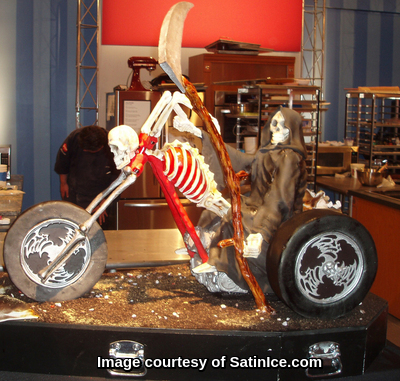 The cake world has evolved tremendously since those days. After the introduction of marzipan, fondant, gum paste, modeling paste, food, and sheen colors, airbrushing, luster dusts, silicone molds, sugar veil, and endless specialty tools and gadgets, this industry has taken on a whole new dimension. The possibilities and especially demands from customers have far outgrown the simplicity of a round cake with a candle. With a passion for sculpting, molding, airbrushing and fine detailed fingertip work, I got sucked right into it, and have watched all the changes, newest trends and innovating products, tools and equipment. There are endless possibilities and, most astonishing, the rapid increase in popularity and participation in this field. We used to be called bakers, then pastry chefs and now cake or sugar artists. TV played a huge role, glamorizing the 3D, novelty, and themed cake industry by creating reality shows and competitions. I know firsthand and have participated in many of them. The bigger, crazier, and more daring, the better: gravity-defying, upside down, extremely realistic looking, and let’s not forget all the added special effects, electronics, built-in speakers, pumps and remote-controlled movements. The list goes on and on and it seems that all that craziness has trumped my mom’s simple cakes in their traditional round shape.
The cake world has evolved tremendously since those days. After the introduction of marzipan, fondant, gum paste, modeling paste, food, and sheen colors, airbrushing, luster dusts, silicone molds, sugar veil, and endless specialty tools and gadgets, this industry has taken on a whole new dimension. The possibilities and especially demands from customers have far outgrown the simplicity of a round cake with a candle. With a passion for sculpting, molding, airbrushing and fine detailed fingertip work, I got sucked right into it, and have watched all the changes, newest trends and innovating products, tools and equipment. There are endless possibilities and, most astonishing, the rapid increase in popularity and participation in this field. We used to be called bakers, then pastry chefs and now cake or sugar artists. TV played a huge role, glamorizing the 3D, novelty, and themed cake industry by creating reality shows and competitions. I know firsthand and have participated in many of them. The bigger, crazier, and more daring, the better: gravity-defying, upside down, extremely realistic looking, and let’s not forget all the added special effects, electronics, built-in speakers, pumps and remote-controlled movements. The list goes on and on and it seems that all that craziness has trumped my mom’s simple cakes in their traditional round shape.
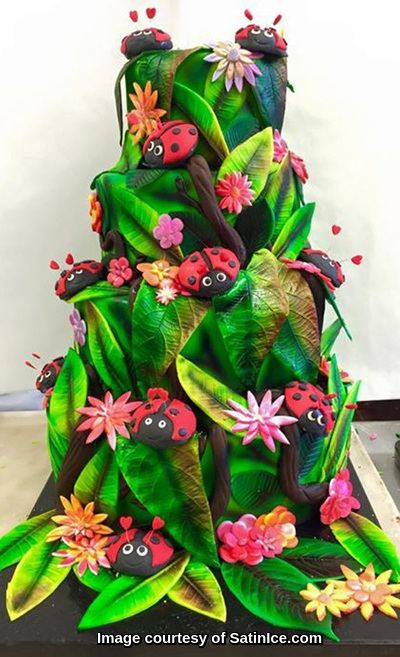 After selling my company, Truly Jörg’s Patisserie, I traveled all over the world and all around the United States teaching classes and working as a consultant. It’s important for me to keep up with new trends, stay current, and observe what the new generation of upcoming cake artists are interested in and passionate about. It used to be that you would go through a culinary or pastry program and then graduate as a pastry chef. These days, we are like doctors; first, you go to med school, then you get specialized in a specific field, i.e., pediatric, orthopedic, brain surgery, cardiac, etc. As pastry chefs, we have very specific options, too: chocolatier; plated desserts in restaurants; hotels; cruise ship industry and resorts; wholesale production; retail pastry shops; test kitchens; and, of course, cake artistry. Today, a lot of cake artists don’t even have a culinary degree; instead, they’ve graduated from art school. It’s become more important to know how to sculpt, draw, understand the color wheel, sketch, and design than to know how to mix butter, sugar, flour and eggs.
After selling my company, Truly Jörg’s Patisserie, I traveled all over the world and all around the United States teaching classes and working as a consultant. It’s important for me to keep up with new trends, stay current, and observe what the new generation of upcoming cake artists are interested in and passionate about. It used to be that you would go through a culinary or pastry program and then graduate as a pastry chef. These days, we are like doctors; first, you go to med school, then you get specialized in a specific field, i.e., pediatric, orthopedic, brain surgery, cardiac, etc. As pastry chefs, we have very specific options, too: chocolatier; plated desserts in restaurants; hotels; cruise ship industry and resorts; wholesale production; retail pastry shops; test kitchens; and, of course, cake artistry. Today, a lot of cake artists don’t even have a culinary degree; instead, they’ve graduated from art school. It’s become more important to know how to sculpt, draw, understand the color wheel, sketch, and design than to know how to mix butter, sugar, flour and eggs.
One trend I noticed over the last few years is that cake artists work from home. This puts them in a whole new category and in fierce competition with retail pastry shops. You can get zoned by the state as a home business and run a novelty cake production right out of your home. Your cost is a fraction of what the professional pastry shop faces. Rent or mortgage is paid because you live there. Utilities such as gas and electricity for refrigeration, heat and air conditioning are not additional costs to what you already use. You get billed as a residence, not based on commercial rates, which are much higher. There is no overhead unless you hire a helper and everybody pays them cash under the table anyway. You produce less but with a much larger profit margin. And, all of this in the comfort of your own home and on your time. It also allows you to multitask, making cakes while simultaneously watching the kids and getting chores done. Over the last decade, I’ve also observed an all-male industry become virtually all female. It’s very rare that I have a male student. The industry is over 90% women and the same percentage are working out of their own home.
Yet these changes have created some incredibly talented sugar artists. I am friends with thousands of cake artists from all over the world on Facebook and when looking at the posted pictures of the sculpted, hand-painted, airbrushed, artistically created pieces, whether they are flowers, figurines, or scenes, I am absolutely blown away by the talent and precision of craftsmanship. Cakes have become so realistic looking, you never know if they are going stay on their cake boards or jump right at you. And, yet among all that incredible talent and artistic ability, there is one thing that so many cake artists are not educated in, have no idea how to approach, fear, or lack the knowledge of and it holds them back from expanding their talents to a whole new level. I am talking about CAKE MECHANICS.
How To Learn Cake Structure
Unfortunately, this is something no culinary or pastry program will even touch upon. I know that some of the most amazing cake artists have to turn down large 3D, novelty and gravity-defying cake orders, not because of their artistic talents, but because they lack the experience in creating the support structure. That’s why so many cakes are small or stacked like a traditional wedding cake. And it’s always the same reason when questioning them: I don’t know how, I have no tools, I have no space to store all those tools, I am afraid I get hurt. And there you have it. All this amazing talent is completely restricted to small, simple layered cakes. This is the reason I created my number one selling class, “Cake Mechanics.” This one class has taken so many of my students to a new level and enabled them to take on new, much larger and more expensive cake projects. The response and messages on Facebook I get is overwhelming. Students will contact me down the road and tell me that the class provided the most important information they got to succeed in their cake journeys. The fact is, close to 100% of cakes we produce have to leave our facilities and need to be transported. And, all my fellow cake brothers and sisters, welcome to the nightmare. This part of our business just plain sucks. It’s stressful and you never know if or when the guy in front of you will lock his brakes. It all comes down to the structural integrity of your support system.
Tools You Will Need
Not accepting any of the excuses, I do understand that it can be pretty intimidating to switch from a fine paintbrush or modeling tool to a 110 V motorized power tool. But people have the wrong perception of the types of power tools actually needed in the building of cake support structures. Automatically, one assumes that a variety of big saws, massive power tools, large drills and hydraulic driven cutting devices are necessary to finish the job. Couple that with the fear of cut off fingers, gushing blood, punctured hands and stitches at the ER. This couldn’t be further from the truth. Just like in our industry and its constant innovation of new gadgets, power tools have come along way. I travel all over the world and some of my gravity-defying cake classes require me to have a full wood and metal workshop with me. That must include anything you can think of to build a solid cake structure, and if that wasn’t enough, it all has to fit in one small bag. Make no mistake, in some corners of the world, I cannot just walk into a Home Depot. What you have is what you get. No plan B. I found the perfect solution a few years back in the Matrix system from Black & Decker. This is the ultimate all-in-one tool that’s interchangeable on a cordless drill as the power source and gear drive. It comes with all the individual attachments that are a mini-size version and perfect in size for what we need. It will allow you to be the MacGyver of novelty cakes. In addition to that, you will need small sets of drill bits, different size screw tips, some pliers, glue, pipe cutters, tape, and some random mechanical stuff. My little workshop bag on the go will allow me to cut any kind of wood, plastic, PVC, and even metal. I can drive-in and tighten any kind of screws or bolts, anchor downpipes to wood, or glue adhesive or epoxy materials to each other.
I have been asked many times to do a demonstration on cake mechanics. My favorite part is when I walk up to the demonstration table in front of a big crowd with a small bag in hand and a piece of wood. Immediately, one person remarks, “Oh, I thought you’re going to show us how to work with tools and build structures!” Perfect! Just what I wanted to hear because I can prove them wrong, right then and there, as I unpack my bag. To their total disbelief, I produce one tool after another, just like a magician pulling out bunnies from his hat. And that’s why I don’t accept any excuses. There are none, and I am here to prove it and am willing to teach you how to overcome your fear of tools and the basics of constructing a legitimate support system for your next level of cake artistry.
So many of us, myself included, are visual learners. Once you start working with simple tools, hardware, and glues to fabricate your own support system, you will get better each time and feel more comfortable. Have no fear, just follow the safety instruction of the tools, and stop relying on other people. Having to hire a carpenter to build your structures is expensive and you’re at the mercy of their availability. Too often, you’ll get a last-minute request and won’t have the leisure of waiting around to have somebody else build the necessary support system for you. The last thing you want to do is to say “no” to the customer. Somebody else will do it, you’ll lose out on business and won’t be called back for similar projects after clarifying that you’re not the person for it. So, be the person that customers go to because they know about your ability to make gravity-defying cakes, appreciate it, and are willing to pay the big bucks for it.
Cake Mechanics Tool Bag
Separate tools into three groups when packing:
1. Interchangeable Attachment System “The Matrix”

Cordless Drill: Drills at different speeds and with a variety of assorted drill bits.
Lithium Battery and Charger: One spare always fully charged battery to avoid waiting time while recharging.
Driver: Drives all screws and bolts into wood or metal. Equipped with an adjustable clutch that ensures no over forced power which can snap off screw heads when tightened too much.
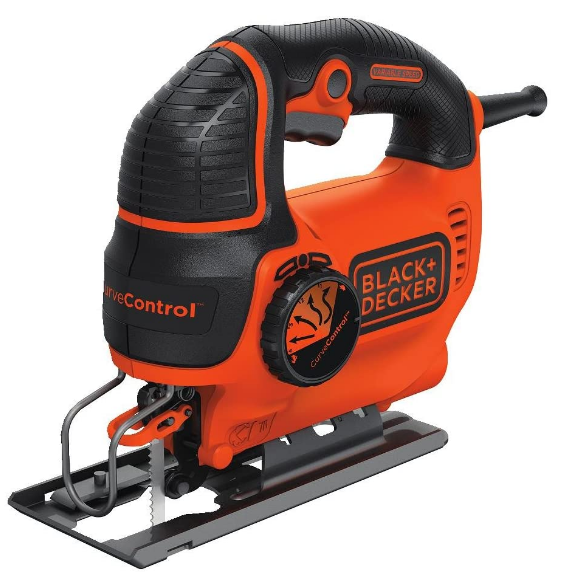
Jig Saw: Precision cuts for funky patterns, tight curves, or rounded corners on platforms or baseboards.
Circular Saw: Perfect for long, straight cuts through large and thin wooden boards.
Fine Saw and Sanding Pad: The ultimate solution for the hard to reach places. The L-shaped saw blade will come in handy in many situations. Also equips with an inner exchangeable sanding pad for the smooth finish look of baseboards.
Zip Lock: Storage and safekeeping of different blades, spare parts, and other attachments and accessories.
2. Tools Attachment Sets and Hardware
Drill Bits: A full set of wood and metal drill bits. One set of paddle bits for larger holes and a hole saw set for large diameter PVC pipe openings.
Screw Tips: One set of a large variety of screw tips from Phillips to flat and square to a hexagon.
Clamps: Perfect to secure glued pieces and to hold different things in place. Also used to clamp down a straight edge to use as a guide for the saw to make precision cuts.
Measuring Tape: Used for all measurements.
Pliers: One pair of vice-grips. Adjustable, to fit any size, and the ability to lock tight.
Pipe Cutter: Adjustable copper pipe cutter for all sizes.
Screws and Bolts: A variety box with different size screws and bolts, nuts and washers.
Drop Cloth: For protection against sawdust and to cover up things.
3. Glues, Epoxies, and Tape
Glue Gun: A must in any cake artist’s tool kit. Used for multiple materials and in many situations.
Super Glue: Quick fix solution. Fast results and good bondage.
Epoxy: A two-part component glue that when mixed and activated will bond any material together. Very strong bondage and quick cure time.
Tape: Standard electrical tape for any and many purposes.

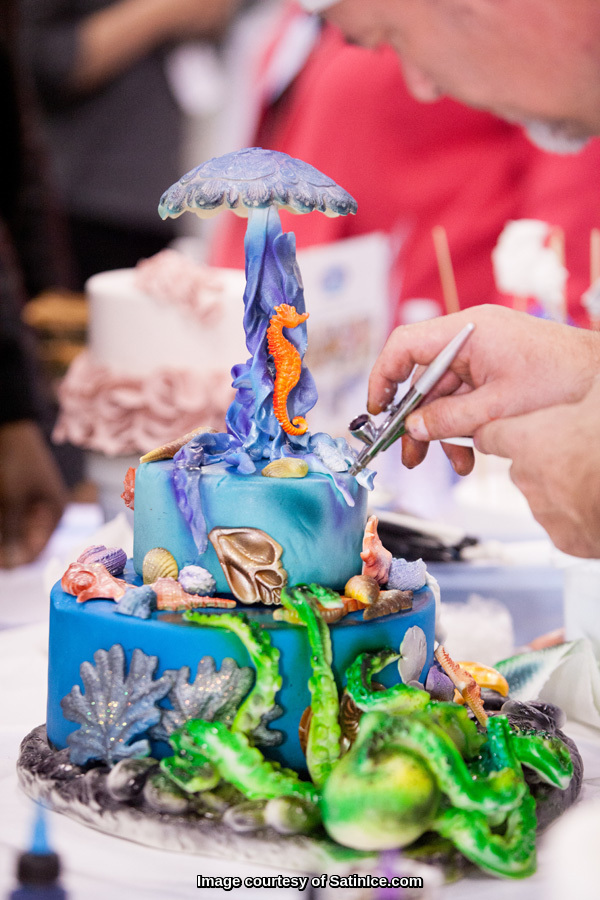
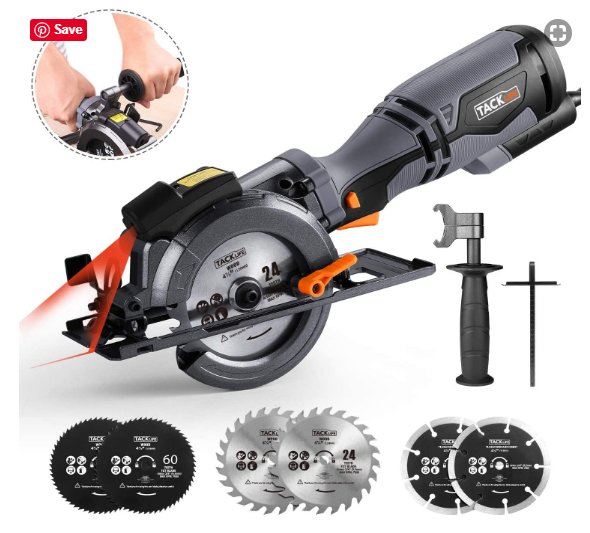
I always appreciate the work ethic needed to get cakes looking as great as they are. There are just cakes that make you wonder “wow, how long did that take to make?” My sister who doesn’t know much about how these cakes are made got shocked when I told her some cakes even need a drill! While I have not made a cake like this recently, this post has inspired me to try it out again. And for that I thank you =)